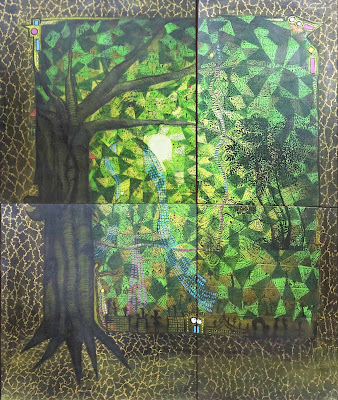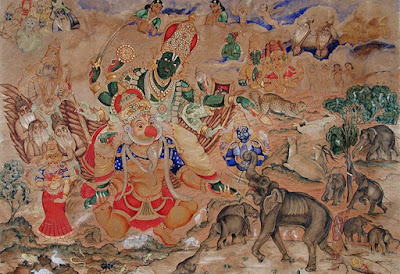Devotion and Contemporary Art in India- part 1
Devotion and Contemporary Art in India- part 1
In India, religion or Bhakti in art is as old as the history of art. According to the scriptures (as they are the eldest writings, not any theory) the first creator of the world is Bhagavan Vishnu. We can find the description of paintings and sculptures in Vedic Literature like in Bhagavata Purana there is a story of Bhakta Prahlad worshipping lord Vishnu’s deity when Lord Vishnu took Narsigha avtaar. In Rama avatar, there is a story of Sitaji praying Goddess Durga deity. There are many stories in ancient Indian Literature which mention deities. However, not much is said about paintings.
As we have for too long disregarded the achievements of early civilizations in India because of mysteries that surrounded it as Indus valley (26 BCE) Mohan Jodaro (2nd BCE).
About art Vincent
van Gogh has said-
“The
emotions are sometimes so strong that I work without knowing it. The strokes
come like speech.”
And you will find similar quotes in devotion,
the devotee surrender himself, and magic happen in life. So although art in
itself is devotion (Bhakti) yet here we will talk about Bhakti (devotion)
movement in Indian literature and then touch on a little in the visual arts.
Art is a
continuous journey with civilization. Just as science invented many things and
provided a lot of convenience to the people, similarly art helps in the
development of the mind of the people and unknowingly it affects society
and culture. In ancient times people made some kind of tribal or folk type of
paintings in caves or later in homes.
Bhakti or
Bhakti in art in India is as old as the history of art. According to the scriptures
(as they are the oldest writings), Brahma is believed to be the world's first
artist. We can find descriptions of paintings and sculpture in Vedic literature
such as in the Bhagavata Purana, the story of the devotee Prahlad worshiping
the deity of Lord Vishnu when Lord Vishnu incarnated as Narasimha. There is a
story of Sita praying to Goddess Durga in Rama avatar. There are many such
stories in ancient Indian literature in which deities are mentioned. However,
there is a description of the painting of Aniruddha in the Mahabharata by
Chitralekha and not much is known about the paintings other than this.
Here we will
first try to understand the Bhakti Movement in literature –
Bhakti Movement
An important milestone in the cultural
history of medieval India was the silent writing revolution in society brought
about by a galaxy of socio-religious reformers, a revolution known as the
Bhakti movement. The movement was responsible for many of the rites and rituals
associated with the Hindus of medieval India (800–1700) and the Muslims and
Sikhs.
The movement
is traditionally regarded as an influential social revival and reformation in
Hinduism and offers a personal-centered alternative path to spirituality
regardless of one's birth or gender. The Bhakti movement started with the aim
of reforming Hinduism. Postmodern scholars question this traditional view and
whether the Bhakti movement was ever some kind of reform. He suggests that the
Bhakti movement was a revival, reworking, and re-reference of ancient Vedic
traditions.
The texts of
the Bhakti movement include the Bhagavad Gita, the Bhagavata Purana, and the
Padma Purana, etc.
As we have
long neglected the achievements of the early civilizations in India because
their secrets surround it from the Indus Valley (26 BC) to Mohenjodaro (2 BC).
Shankaracharya,
the leader of the Hindu revivalist movement, was a great thinker and eminent
philosopher.
Although the
Bhakti movement originated in Tamil Nadu during the 6th to 8th centuries,
spread northwards from Tamil Nadu through Karnataka, and gained widespread
acceptance in Bengal and northern India in the fifteenth century. The Bhagavata
Purana, the emphasis on devotion by the South Indian Alvar sages, has been
attributed by many scholars to South Indian origin, although some scholars
question whether this evidence excludes this possibility. A parallel development
took place in other parts of the Bhakti movement. Like the Alvars, the Shaiva
Nayanar poets were influential. Tirumurai, a compilation of rhymes on Shiva by
sixty-three Nayanar poet-saints, developed into an influential treatise in
Shaivism. Early Tamil-Shiva Bhakti poets influenced Hindu texts that were
revered throughout India.
An important
thread of the Bhakti moment is the Radha Bhallabha sect which is based on Radha
Krishna's spiritual love. To this day in Brijbhumi, you can find many murals and
songs of this cult.
This
literature includes the writings of Kabir, Nanak (founder of Sikhism),
Tulsidas, Nabha Das, Gusainji, Ghanananda,] Ramananda (founder of Ramanandi
sect), Sripadaraja, Vyasatirtha, Kanakadas, Vijay Das, the six Goswamis of
Vrindavan, Raskhan. Huh. Teachings of saints like Ravidas, Jayadeva Goswami,
Namdev, Eknath, Tukaram, Mirabai, Ramprasad Sen, Sankardev, Vallabh Acharya
Narasimha Mehta, Gangasati, and Chaitanya Mahaprabhu. Writers from the 7th to
the early 10th centuries are known to have influenced the poet-saint-driven
movement. Sambandar, Tirunavukkarasar, Sundarar, Nammalvar, Adishankar,
Manikvakakar and Nathamuni. Several writers of the 11th and 12th centuries
developed different philosophies within the Vedanta school of Hinduism, which
were influential to the Bhakti tradition in medieval India. Include Ramanuja,
Madhava, Vallabh and Nimbarka. These authors supported a spectrum of
philosophical positions ranging from theistic dualism, qualified monism, and
absolute monism.
👉if this blog is in any way helpful to you or what is your opinion about this or on what topic you want to see the next blog - please comment below. 🙏









Comments
Post a Comment